The case study shown below provides an overview of Road Transit Systems (RTS) - a specialist preventative vehicle maintenance program operator in NSW, Australia.
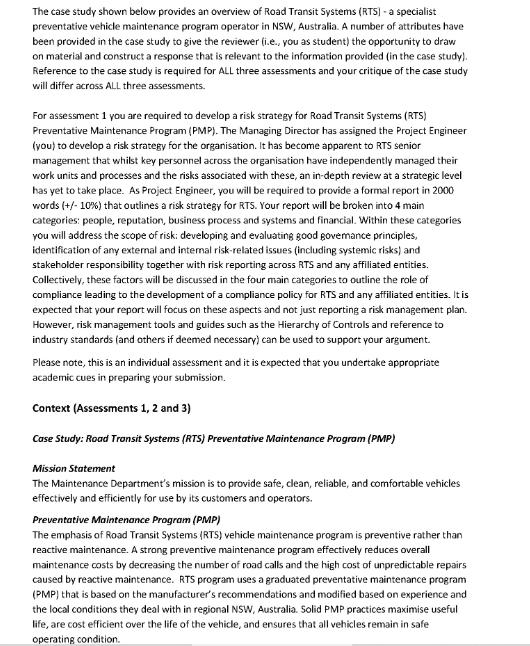
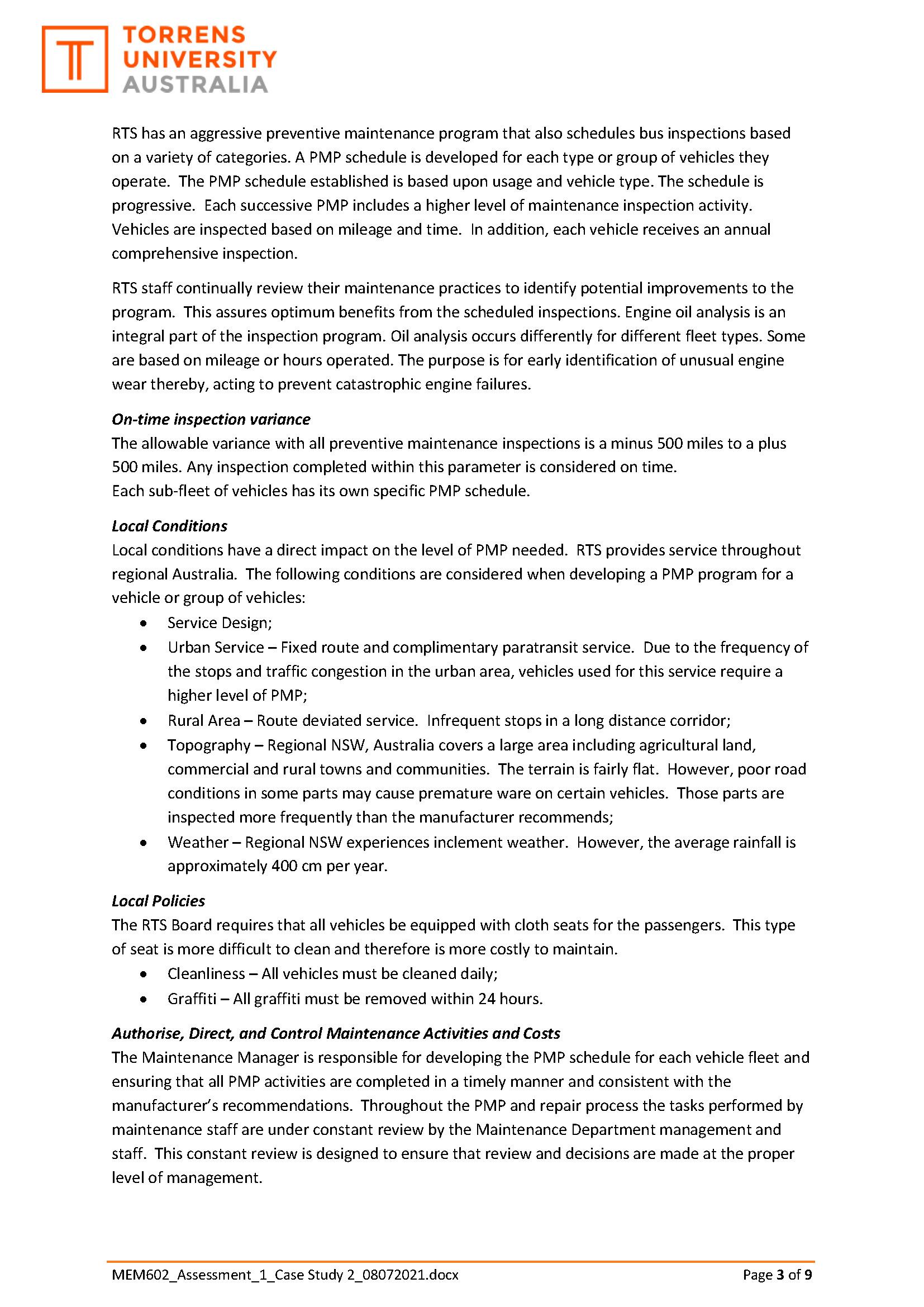
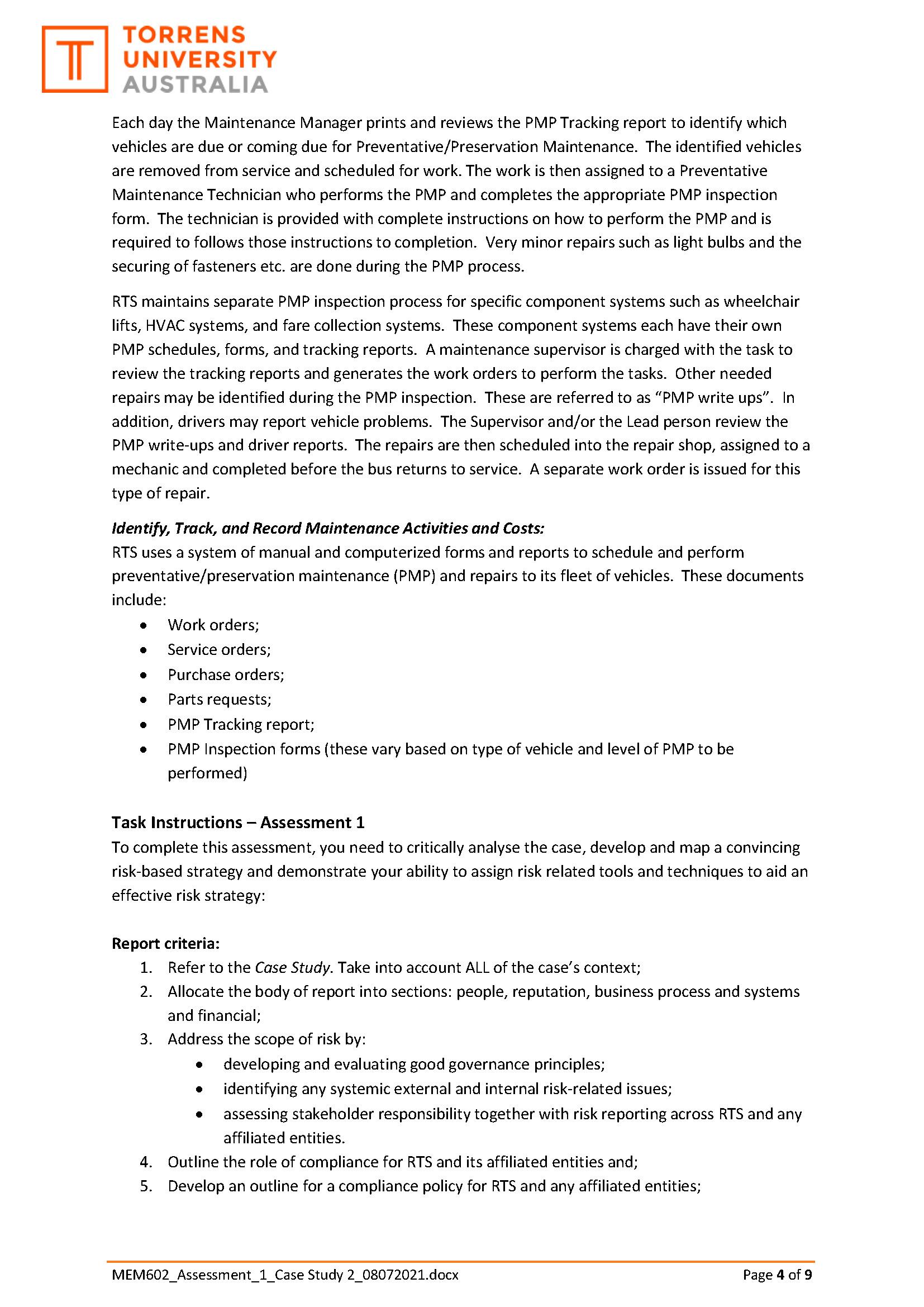
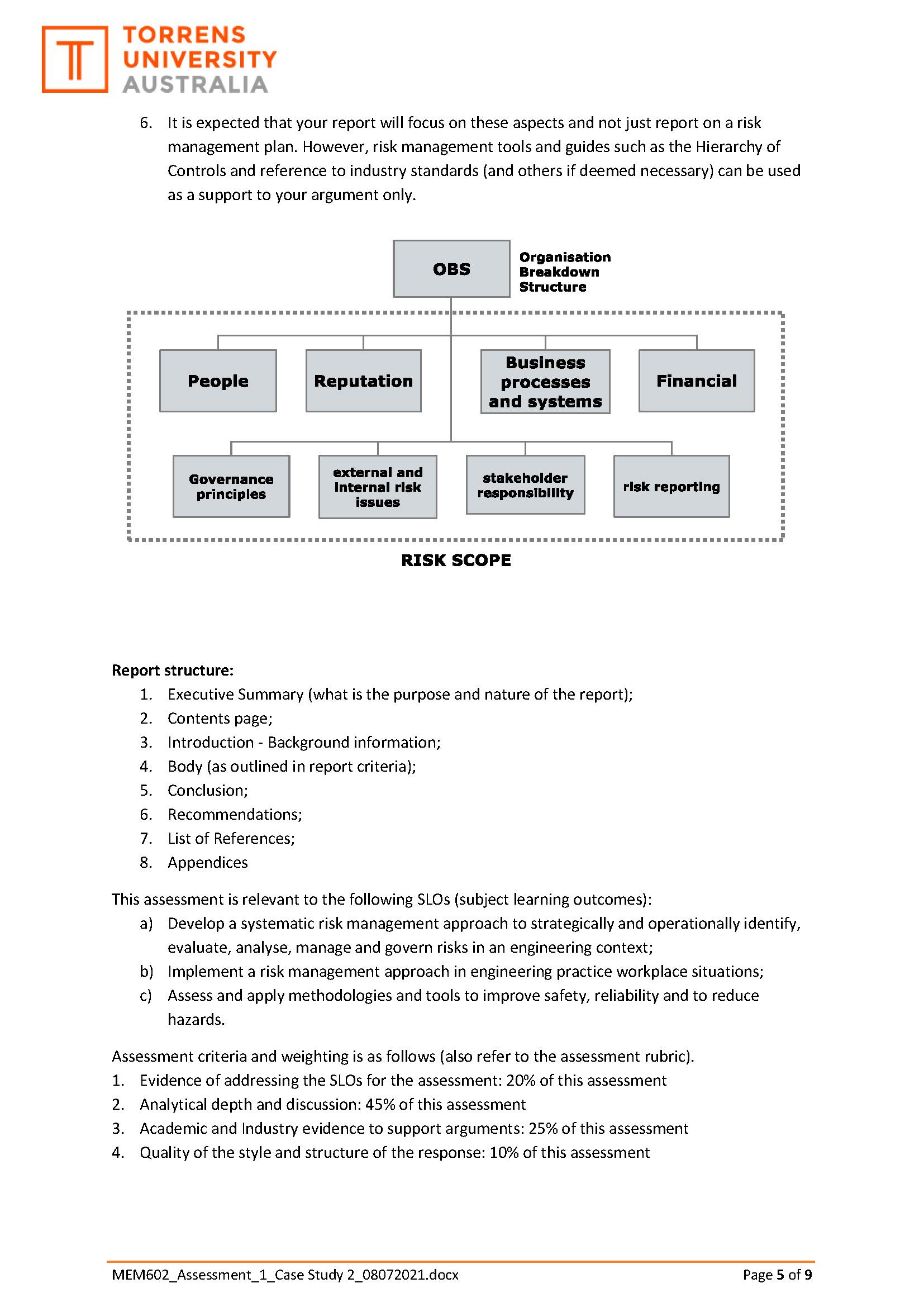
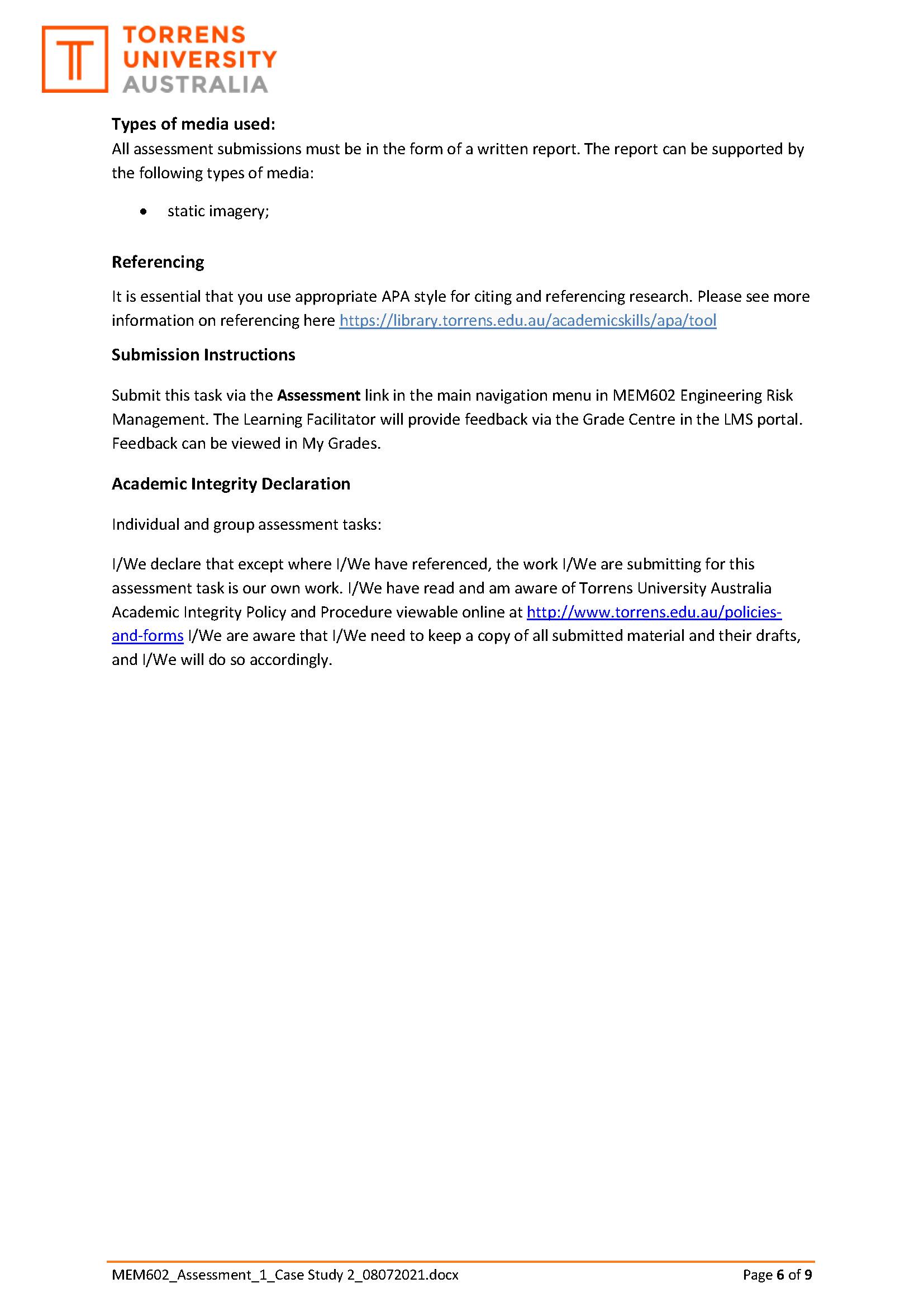

The case study shown below provides an overview of Road Transit Systems (RTS) - a specialist preventative vehicle maintenance program operator in NSW, Australia. A number of attributes have been provided in the case study to give the reviewer (i.e., you as student) the opportunity to draw on material and construct a response that is relevant to the information provided (in the case study). Reference to the case study is required for ALL three assessments and your critique of the case study will differ across ALL three assessments. For assessment 1 you are required to develop a risk strategy for Road Transit Systems (RTS) Preventative Maintenance Program (PMP). The Managing Director has assigned the Project Engineer (you) to develop a risk strategy for the organisation. It has become apparent to RTS senior management that whilst key personnel across the organisation have independently managed their work units and processes and the risks associated with these, an in-depth review at a strategic level has yet to take place. As Project Engineer, you will be required to provide a formal report in 2000 words (+/- 10%) that outlines a risk strategy for RTS. Your report will be broken into 4 main categories: people, reputation, business process and systems and financial. Within these categories you will address the scope of risk: developing and evaluating good governance principles, identification of any external and internal risk-related issues (including systemic risks) and stakeholder responsibility together with risk reporting across RTS and any affiliated entities. Collectively, these factors will be discussed in the four main categories to outline the role of compliance leading to the development of a compliance policy for RTS and any affiliated entities. It is expected that your report will focus on these aspects and not just reporting a risk management plan. However, risk management tools and guides such as the Hierarchy of Controls and reference to industry standards (and others if deemed necessary) can be used to support your argument. Please note, this is an individual assessment and it is expected that you undertake appropriate academic cues in preparing your submission. Context (Assessments 1, 2 and 3) Case Study: Road Transit Systems (RTS) Preventative Maintenance Program (PMP) Mission Statement The Maintenance Department's mission is to provide safe, clean, reliable, and comfortable vehicles effectively and efficiently for use by its customers and operators. Preventative Maintenance Program (PMP) The emphasis of Road Transit Systems (RTS) vehicle maintenance program is preventive rather than reactive maintenance. A strong preventive maintenance program effectively reduces overall maintenance costs by decreasing the number of road calls and the high cost of unpredictable repairs caused by reactive maintenance. RTS program uses a graduated preventative maintenance program (PMP) that is based on the manufacturer's recommendations and modified based on experience and the local conditions they deal with in regional NSW, Australia. Solid PMP practices maximise useful life, are cost efficient over the life of the vehicle, and ensures that all vehicles remain in safe operating condition. TORRENS TUNIVERSITY AUSTRALIA RTS has an aggressive preventive maintenance program that also schedules bus inspections based on a variety of categories. A PMP schedule is developed for each type or group of vehicles they operate. The PMP schedule established is based upon usage and vehicle type. The schedule is progressive. Each successive PMP includes a higher level of maintenance inspection activity. Vehicles are inspected based on mileage and time. In addition, each vehicle receives an annual comprehensive inspection. RTS staff continually review their maintenance practices to identify potential improvements to the program. This assures optimum benefits from the scheduled inspections. Engine oil analysis is an integral part of the inspection program. Oil analysis occurs differently for different fleet types. Some are based on mileage or hours operated. The purpose is for early identification of unusual engine wear thereby, acting to prevent catastrophic engine failures. On-time inspection variance The allowable variance with all preventive maintenance inspections is a minus 500 miles to a plus 500 miles. Any inspection completed within this parameter is considered on time. Each sub-fleet of vehicles has its own specific PMP schedule. Local Conditions Local conditions have a direct impact on the level of PMP needed. RTS provides service throughout regional Australia. The following conditions are considered when developing a PMP program for a vehicle or group of vehicles: Service Design; Urban Service - Fixed route and complimentary paratransit service. Due to the frequency of the stops and traffic congestion in the urban area, vehicles used for this service require a higher level of PMP; Rural Area - Route deviated service. Infrequent stops in a long distance corridor; Topography - Regional NSW, Australia covers a large area including agricultural land, commercial and rural towns and communities. The terrain is fairly flat. However, poor road conditions in some parts may cause premature ware on certain vehicles. Those parts are inspected more frequently than the manufacturer recommends; Weather - Regional NSW experiences inclement weather. However, the average rainfall is approximately 400 cm per year. Local Policies The RTS Board requires that all vehicles be equipped with cloth seats for the passengers. This type of seat is more difficult to clean and therefore is more costly to maintain. Cleanliness - All vehicles must be cleaned daily; Graffiti - All graffiti must be removed within 24 hours. Authorise, Direct, and Control Maintenance Activities and Costs The Maintenance Manager is responsible for developing the PMP schedule for each vehicle fleet and ensuring that all PMP activities are completed in a timely manner and consistent with the manufacturer's recommendations. Throughout the PMP and repair process the tasks performed by maintenance staff are under constant review by the Maintenance Department management and staff. This constant review is designed to ensure that review and decisions are made at the proper level of management. MEM602_Assessment_1_Case Study 2_08072021.docx Page 3 of 9 TORRENS TUNIVERSITY AUSTRALIA Each day the Maintenance Manager prints and reviews the PMP Tracking report to identify which vehicles are due or coming due for Preventative/Preservation Maintenance. The identified vehicles are removed from service and scheduled for work. The work is then assigned to a Preventative Maintenance Technician who performs the PMP and completes the appropriate PMP inspection form. The technician is provided with complete instructions on how to perform the PMP and is required to follows those instructions to completion. Very minor repairs such as light bulbs and the securing of fasteners etc. are done during the PMP process. RTS maintains separate PMP inspection process for specific component systems such as wheelchair lifts, HVAC systems, and fare collection systems. These component systems each have their own PMP schedules, forms, and tracking reports. A maintenance supervisor is charged with the task to review the tracking reports and generates the work orders to perform the tasks. Other needed repairs may be identified during the PMP inspection. These are referred to as "PMP write ups". In addition, drivers may report vehicle problems. The Supervisor and/or the Lead person review the PMP write-ups and driver reports. The repairs are then scheduled into the repair shop, assigned to a mechanic and completed before the bus returns to service. A separate work order is issued for this type of repair. Identify, Track, and Record Maintenance Activities and Costs: RTS uses a system of manual and computerized forms and reports to schedule and perform preventative/preservation maintenance (PMP) and repairs to its fleet of vehicles. These documents include: Work orders; Service orders; Purchase orders; Parts requests; PMP Tracking report; PMP Inspection forms (these vary based on type of vehicle and level of PMP to be performed) Task Instructions - Assessment 1 To complete this assessment, you need to critically analyse the case, develop and map a convincing risk-based strategy and demonstrate your ability to assign risk related tools and techniques to aid an effective risk strategy: Report criteria: 1. Refer to the Case Study. Take into account ALL of the case's context; 2. Allocate the body of report into sections: people, reputation, business process and systems and financial; 3. Address the scope of risk by: developing and evaluating good governance principles; identifying any systemic external and internal risk-related issues; assessing stakeholder responsibility together with risk reporting across RTS and any affiliated entities. 4. Outline the role of compliance for RTS and its affiliated entities and; 5. Develop an outline for a compliance policy for RTS and any affiliated entities; MEM602_Assessment_1_Case Study 2_08072021.docx Page 4 of 9 TORRENS TUNIVERSITY AUSTRALIA 6. It is expected that your report will focus on these aspects and not just report on a risk management plan. However, risk management tools and guides such as the Hierarchy of Controls and reference to industry standards (and others if deemed necessary) can be used as a support to your argument only. People Governance principles Reputation OBS external and Internal risk issues Organisation Breakdown Structure Business processes and systems RISK SCOPE 3. Introduction - Background information; 4. Body (as outlined in report criteria); 5. Conclusion; 6. Recommendations; 7. List of References; 8. Appendices stakeholder responsibility 4 Report structure: 1. Executive Summary (what is the purpose and nature of the report); 2. Contents page; MEM602_Assessment_1_Case Study 2_08072021.docx Financial risk reporting This assessment is relevant to the following SLOS (subject learning outcomes): a) Develop a systematic risk management approach to strategically and operationally identify, evaluate, analyse, manage and govern risks in an engineering context; b) Implement a risk management approach in engineering practice workplace situations; c) Assess and apply methodologies and tools to improve safety, reliability and to reduce hazards. Assessment criteria and weighting is as follows (also refer to the assessment rubric). 1. Evidence of addressing the SLOs for the assessment: 20% of this assessment 2. Analytical depth and discussion: 45% of this assessment 3. Academic and Industry evidence to support arguments: 25% of this assessment 4. Quality of the style and structure of the response: 10% of this assessment Page 5 of 9 TORRENS TUNIVERSITY AUSTRALIA Types of media used: All assessment submissions must be in the form of a written report. The report can be supported by the following types of media: static imagery; Referencing It is essential that you use appropriate APA style for citing and referencing research. Please see more information on referencing here https://library.torrens.edu.au/academicskills/apa/tool Submission Instructions Submit this task via the Assessment link in the main navigation menu in MEM602 Engineering Risk Management. The Learning Facilitator will provide feedback via the Grade Centre in the LMS portal. Feedback can be viewed in My Grades. Academic Integrity Declaration Individual and group assessment tasks: I/We declare that except where I/We have referenced, the work I/We are submitting for this assessment task is our own work. I/We have read and am aware of Torrens University Australia Academic Integrity Policy and Procedure viewable online at http://www.torrens.edu.au/policies- and-forms I/We are aware that I/We need to keep a copy of all submitted material and their drafts, and I/We will do so accordingly. MEM602_Assessment_1_Case Study 2_08072021.docx Page 6 of 9 TORRENS TUNIVERSITY AUSTRALIA Subject Code and Title Assessment Individual/Group Length Learning Outcomes Submission Weighting Total Marks ASSESSMENT 1 BRIEF MEM602 Engineering Risk Management Engineering Risk Management Case Study Individual 2000 words +/- 10% The Subject Learning Outcomes demonstrated by successful completion of the task below include: a) Develop a systematic risk management approach to strategically and operationally identify, evaluate, analyse, manage and govern risks in an engineering context. b) Implement a risk management approach in engineering practice workplace situations. c) Assess and apply methodologies and tools to improve safety, reliability and to reduce hazards. Due by 11:55pm AEST/AEDT Sunday end of Module 3.1 (Week 5) 30% 100 marks MEM602_Assessment_1_Case Study 2_08072021.docx Page 1 of 9 The case study shown below provides an overview of Road Transit Systems (RTS) - a specialist preventative vehicle maintenance program operator in NSW, Australia. A number of attributes have been provided in the case study to give the reviewer (i.e., you as student) the opportunity to draw on material and construct a response that is relevant to the information provided (in the case study). Reference to the case study is required for ALL three assessments and your critique of the case study will differ across ALL three assessments. For assessment 1 you are required to develop a risk strategy for Road Transit Systems (RTS) Preventative Maintenance Program (PMP). The Managing Director has assigned the Project Engineer (you) to develop a risk strategy for the organisation. It has become apparent to RTS senior management that whilst key personnel across the organisation have independently managed their work units and processes and the risks associated with these, an in-depth review at a strategic level has yet to take place. As Project Engineer, you will be required to provide a formal report in 2000 words (+/- 10%) that outlines a risk strategy for RTS. Your report will be broken into 4 main categories: people, reputation, business process and systems and financial. Within these categories you will address the scope of risk: developing and evaluating good governance principles, identification of any external and internal risk-related issues (including systemic risks) and stakeholder responsibility together with risk reporting across RTS and any affiliated entities. Collectively, these factors will be discussed in the four main categories to outline the role of compliance leading to the development of a compliance policy for RTS and any affiliated entities. It is expected that your report will focus on these aspects and not just reporting a risk management plan. However, risk management tools and guides such as the Hierarchy of Controls and reference to industry standards (and others if deemed necessary) can be used to support your argument. Please note, this is an individual assessment and it is expected that you undertake appropriate academic cues in preparing your submission. Context (Assessments 1, 2 and 3) Case Study: Road Transit Systems (RTS) Preventative Maintenance Program (PMP) Mission Statement The Maintenance Department's mission is to provide safe, clean, reliable, and comfortable vehicles effectively and efficiently for use by its customers and operators. Preventative Maintenance Program (PMP) The emphasis of Road Transit Systems (RTS) vehicle maintenance program is preventive rather than reactive maintenance. A strong preventive maintenance program effectively reduces overall maintenance costs by decreasing the number of road calls and the high cost of unpredictable repairs caused by reactive maintenance. RTS program uses a graduated preventative maintenance program (PMP) that is based on the manufacturer's recommendations and modified based on experience and the local conditions they deal with in regional NSW, Australia. Solid PMP practices maximise useful life, are cost efficient over the life of the vehicle, and ensures that all vehicles remain in safe operating condition. TORRENS TUNIVERSITY AUSTRALIA RTS has an aggressive preventive maintenance program that also schedules bus inspections based on a variety of categories. A PMP schedule is developed for each type or group of vehicles they operate. The PMP schedule established is based upon usage and vehicle type. The schedule is progressive. Each successive PMP includes a higher level of maintenance inspection activity. Vehicles are inspected based on mileage and time. In addition, each vehicle receives an annual comprehensive inspection. RTS staff continually review their maintenance practices to identify potential improvements to the program. This assures optimum benefits from the scheduled inspections. Engine oil analysis is an integral part of the inspection program. Oil analysis occurs differently for different fleet types. Some are based on mileage or hours operated. The purpose is for early identification of unusual engine wear thereby, acting to prevent catastrophic engine failures. On-time inspection variance The allowable variance with all preventive maintenance inspections is a minus 500 miles to a plus 500 miles. Any inspection completed within this parameter is considered on time. Each sub-fleet of vehicles has its own specific PMP schedule. Local Conditions Local conditions have a direct impact on the level of PMP needed. RTS provides service throughout regional Australia. The following conditions are considered when developing a PMP program for a vehicle or group of vehicles: Service Design; Urban Service - Fixed route and complimentary paratransit service. Due to the frequency of the stops and traffic congestion in the urban area, vehicles used for this service require a higher level of PMP; Rural Area - Route deviated service. Infrequent stops in a long distance corridor; Topography - Regional NSW, Australia covers a large area including agricultural land, commercial and rural towns and communities. The terrain is fairly flat. However, poor road conditions in some parts may cause premature ware on certain vehicles. Those parts are inspected more frequently than the manufacturer recommends; Weather - Regional NSW experiences inclement weather. However, the average rainfall is approximately 400 cm per year. Local Policies The RTS Board requires that all vehicles be equipped with cloth seats for the passengers. This type of seat is more difficult to clean and therefore is more costly to maintain. Cleanliness - All vehicles must be cleaned daily; Graffiti - All graffiti must be removed within 24 hours. Authorise, Direct, and Control Maintenance Activities and Costs The Maintenance Manager is responsible for developing the PMP schedule for each vehicle fleet and ensuring that all PMP activities are completed in a timely manner and consistent with the manufacturer's recommendations. Throughout the PMP and repair process the tasks performed by maintenance staff are under constant review by the Maintenance Department management and staff. This constant review is designed to ensure that review and decisions are made at the proper level of management. MEM602_Assessment_1_Case Study 2_08072021.docx Page 3 of 9 TORRENS TUNIVERSITY AUSTRALIA Each day the Maintenance Manager prints and reviews the PMP Tracking report to identify which vehicles are due or coming due for Preventative/Preservation Maintenance. The identified vehicles are removed from service and scheduled for work. The work is then assigned to a Preventative Maintenance Technician who performs the PMP and completes the appropriate PMP inspection form. The technician is provided with complete instructions on how to perform the PMP and is required to follows those instructions to completion. Very minor repairs such as light bulbs and the securing of fasteners etc. are done during the PMP process. RTS maintains separate PMP inspection process for specific component systems such as wheelchair lifts, HVAC systems, and fare collection systems. These component systems each have their own PMP schedules, forms, and tracking reports. A maintenance supervisor is charged with the task to review the tracking reports and generates the work orders to perform the tasks. Other needed repairs may be identified during the PMP inspection. These are referred to as "PMP write ups". In addition, drivers may report vehicle problems. The Supervisor and/or the Lead person review the PMP write-ups and driver reports. The repairs are then scheduled into the repair shop, assigned to a mechanic and completed before the bus returns to service. A separate work order is issued for this type of repair. Identify, Track, and Record Maintenance Activities and Costs: RTS uses a system of manual and computerized forms and reports to schedule and perform preventative/preservation maintenance (PMP) and repairs to its fleet of vehicles. These documents include: Work orders; Service orders; Purchase orders; Parts requests; PMP Tracking report; PMP Inspection forms (these vary based on type of vehicle and level of PMP to be performed) Task Instructions - Assessment 1 To complete this assessment, you need to critically analyse the case, develop and map a convincing risk-based strategy and demonstrate your ability to assign risk related tools and techniques to aid an effective risk strategy: Report criteria: 1. Refer to the Case Study. Take into account ALL of the case's context; 2. Allocate the body of report into sections: people, reputation, business process and systems and financial; 3. Address the scope of risk by: developing and evaluating good governance principles; identifying any systemic external and internal risk-related issues; assessing stakeholder responsibility together with risk reporting across RTS and any affiliated entities. 4. Outline the role of compliance for RTS and its affiliated entities and; 5. Develop an outline for a compliance policy for RTS and any affiliated entities; MEM602_Assessment_1_Case Study 2_08072021.docx Page 4 of 9 TORRENS TUNIVERSITY AUSTRALIA 6. It is expected that your report will focus on these aspects and not just report on a risk management plan. However, risk management tools and guides such as the Hierarchy of Controls and reference to industry standards (and others if deemed necessary) can be used as a support to your argument only. People Governance principles Reputation OBS external and Internal risk issues Organisation Breakdown Structure Business processes and systems RISK SCOPE 3. Introduction - Background information; 4. Body (as outlined in report criteria); 5. Conclusion; 6. Recommendations; 7. List of References; 8. Appendices stakeholder responsibility 4 Report structure: 1. Executive Summary (what is the purpose and nature of the report); 2. Contents page; MEM602_Assessment_1_Case Study 2_08072021.docx Financial risk reporting This assessment is relevant to the following SLOS (subject learning outcomes): a) Develop a systematic risk management approach to strategically and operationally identify, evaluate, analyse, manage and govern risks in an engineering context; b) Implement a risk management approach in engineering practice workplace situations; c) Assess and apply methodologies and tools to improve safety, reliability and to reduce hazards. Assessment criteria and weighting is as follows (also refer to the assessment rubric). 1. Evidence of addressing the SLOs for the assessment: 20% of this assessment 2. Analytical depth and discussion: 45% of this assessment 3. Academic and Industry evidence to support arguments: 25% of this assessment 4. Quality of the style and structure of the response: 10% of this assessment Page 5 of 9 TORRENS TUNIVERSITY AUSTRALIA Types of media used: All assessment submissions must be in the form of a written report. The report can be supported by the following types of media: static imagery; Referencing It is essential that you use appropriate APA style for citing and referencing research. Please see more information on referencing here https://library.torrens.edu.au/academicskills/apa/tool Submission Instructions Submit this task via the Assessment link in the main navigation menu in MEM602 Engineering Risk Management. The Learning Facilitator will provide feedback via the Grade Centre in the LMS portal. Feedback can be viewed in My Grades. Academic Integrity Declaration Individual and group assessment tasks: I/We declare that except where I/We have referenced, the work I/We are submitting for this assessment task is our own work. I/We have read and am aware of Torrens University Australia Academic Integrity Policy and Procedure viewable online at http://www.torrens.edu.au/policies- and-forms I/We are aware that I/We need to keep a copy of all submitted material and their drafts, and I/We will do so accordingly. MEM602_Assessment_1_Case Study 2_08072021.docx Page 6 of 9 TORRENS TUNIVERSITY AUSTRALIA Subject Code and Title Assessment Individual/Group Length Learning Outcomes Submission Weighting Total Marks ASSESSMENT 1 BRIEF MEM602 Engineering Risk Management Engineering Risk Management Case Study Individual 2000 words +/- 10% The Subject Learning Outcomes demonstrated by successful completion of the task below include: a) Develop a systematic risk management approach to strategically and operationally identify, evaluate, analyse, manage and govern risks in an engineering context. b) Implement a risk management approach in engineering practice workplace situations. c) Assess and apply methodologies and tools to improve safety, reliability and to reduce hazards. Due by 11:55pm AEST/AEDT Sunday end of Module 3.1 (Week 5) 30% 100 marks MEM602_Assessment_1_Case Study 2_08072021.docx Page 1 of 9
Step by Step Solution
3.55 Rating (159 Votes )
There are 3 Steps involved in it
Step: 1
It seems like RTS Regional Transit Service has a comprehensive the specific needs of different vehic...
See step-by-step solutions with expert insights and AI powered tools for academic success
Step: 2

Step: 3

Ace Your Homework with AI
Get the answers you need in no time with our AI-driven, step-by-step assistance
Get Started


